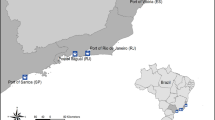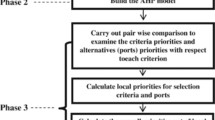Abstract
The studies investigating the port selection process had one thing in common: they analyse the declared preferences of the port agents. However, it is difficult to identify the relevant variables in this process because of the heterogeneity of this group. In this article, we suggest to study the port choice through revealed port selection instead of asking port stakeholders about the main factors in port selection. We propose to analyse the actual inter-port traffic distribution from a holistic view using the hinterland perspective and the discrete choice modelling approach in order to answer the question: Does the location of a port still remain important in port selection? As a case study, we use the Spanish inter-port container distribution among the main peninsular ports.
Similar content being viewed by others
Notes
We observe that the value of the Cramer coefficient V for the model with only the distance is better than the corresponding for the better model from the point of view of the likelihood. The reason for this is the Maximum Likelihood Estimators (MLE) are efficient and asymptotically unbiased but not robust, so they can be strongly influenced by outlier observations, as it is the case in this article.
References
Bergantino, A.S. (2002) The European Commission approach to port policy: Some open issues. International Journal of Transport Economics XXIX (3): 337–379.
Bichou, K. and Gray, R. (2005) A critical review of conventional terminology for classifying seaports. Transportation Research Part A 39: 75–92.
Brooks, M.R. (1990) Ocean carrier selection criteria in a new environment. Logistics and Transportation Review 26: 339–355.
Chasco, C. and Vicéns, J. (1998) Spatial interaction models applied to the design of retail trade areas. 38th Congress of the European Regional Science Association. Vienna, Austria: Wirtschaftuniversität.
D’Este, G.M. (1992) Carrier selection in a ro/ro ferry trade. Part 2. Conceptual framework for the decision process. Maritime Policy and Management 19 (2): 127–138.
D’Este, G.M. and Meyrick, S. (1992) Carrier selection in a Ro/Ro ferry trade. Part 1. Decision factors and attitudes. Maritime Policy and Management 19 (2): 115–126.
De, P. and Park, R. (2003) Container port system concentration. Transportation Quarterly 57 (4): 69–82.
Fleming, D.K. and Hayuth, Y. (1994) Spatial characteristics of transportation hubs: Centrality and intermediacy. Journal of Transport Geography 2 (1): 3–18.
Foster, T. (1977) Ports: What shippers should look for. Distribution Worldwide 77 (1): 40–43.
Foster, T. (1978) Ports: What shippers do look for. Distribution Worldwide 77 (1): 44–48.
Fotheringham, A.S. (1983) A new set of spatial interaction models: The theory of competing destinations. Environment and Planning A 15: 15–36.
Fotheringham, A.S. and O’Kelly, M.E. (1989) Spatial interaction models: Formulations and applications. Studies in Operational Regional Science. Dordrecht, The Netherlands: Kluwer Academic Publishers.
Garcia-Alonso, L. and Sanchez-Soriano, J. (2007) Structure, Location, Performance: The Paradigm of the Spanish Port Sector, Proceedings of IAME, Athens, Greece.
Gouvernal, E., Debrie, J. and Slack, B. (2005) Dynamics of change in the port system of the western Mediterranean. Maritime Policy and Management 32 (2): 107–121.
Huff, D.L. (1963) A probabilistic analysis of consumer spatial behaviour. In: W.S. Decker (ed.) Emerging Concepts Inmarketing. Chicago, IL: American Marketing Association, pp. 443–461.
Lago, A., Malchow, M. and Kanafani, A. (2001) An analysis of carriers’ schedules and the impact on port selection. Presentation at 2001 International Association of Maritime Economists Conference, Hong Kong, China.
Lirn, T.C., Thanopoulou, H.A., Beynon, M.J. and Beresford, A. (2004) An application of AHP on transhipment port selection: A global perspective. Maritime Economics and Logistics 6 (1): 70–91.
Luce, R. (1959) Individual Choice Behaviour. New York: John Wiley & Sons.
Magala, M. and Sammons, A. (2008) A new approach to port choice modelling. Maritime Economics and Logistics 10 (1/2): 9–34.
Malchow, M. and Kanafani, A. (2004) A disaggregate analysis of port selection. Transportation Research. Part E 40 (4): 317–337.
Mangan, J., Lalwani, C. and Gardner, B. (2001) Identifying relevant variables and modelling the choice process in freight transportation. International Journal of Maritime Economics 3 (3): 278–297.
Matear, S. and Gray, R. (1993) Factors influencing freight service choice for shippers and freight suppliers. International Journal of Physical Distribution and Logistics Management 23: 25–35.
McFadden, D. (1974) Conditional Logit Analysis of Qualitative Choice Bahaviour. Frontiers in Econometrics, In: P. Zarembka (ed.) New York: Academic Press.
Murphy, P.R., Daley, J.M. and Hall, P. (1997) Carrier selection: Do shippers and carriers agree, or not? Transportation Research. Part E 33 (1): 67–72.
Robinson, R. (2002) Ports as elements in value-driven chain systems: The new paradigm. Maritime Policy and Management 29: 241–255.
Sargent, A.J. (1938) Seaports and Hinterlands. London: Adam and Charles Black.
Slack, B. (1985) Containerization, inter-port competition and port selection. Maritime Policy and Management 12 (4): 293–303.
Ugboma, C., Ugboma, O. and Ogwude, I.C. (2006) An analytic hierarchy process (AHP) approach to port selection decisions-empirical evidence from Nigerian ports. Maritime Economics and Logistics 8 (3): 251–266.
Yap, W.Y. and Lam, J.S.L. (2006) Competition dynamics between container ports in East Asia. Transportation Research Part A 40: 35–51.
Acknowledgements
A preliminary version of this article was presented at the 2007 IAME Conference. We thank all comments from the reviewers and the participants at the Congress. We also thank José Ángel Vallejo-Pinto, professor in the Computer Science Department at the Oviedo University (Spain), for his technical support. Financial support from the Government of Spain and FEDER, under project MTM2008-06778-C02-01, is gratefully acknowledged.
Author information
Authors and Affiliations
Corresponding author
Appendix
Appendix
The system of first derivatives of the log-likelihood function (6) is given by the following expression:

The Hessian matrix is given by the following expressions of the second derivatives of the log-likelihood function:

where 
Some nice mathematical properties of our multinomial logit conditional model are the following:
-
1
Multiplicative scale changes in the traffic flows, y ij i∈R and j∈P, do not modify the solutions of system (A.1). Therefore, the estimation of the parameters in our model does not depend on the particular way of measuring the traffic flows.
-
2
Multiplicative scale changes in the distances by a constant k modify the solutions of system (A.1) in the following way: the value of the a j s are the same and the new value of d is obtained dividing by k.
-
3
If (a1, a2, …, a p , d) is a solution for system (A.1), then (a1+k, a2+k, …, a p +k, d) is also a solution for system (A.1).
Rights and permissions
About this article
Cite this article
Garcia-Alonso, L., Sanchez-Soriano, J. Port selection from a hinterland perspective. Marit Econ Logist 11, 260–269 (2009). https://doi.org/10.1057/mel.2009.9
Published:
Issue Date:
DOI: https://doi.org/10.1057/mel.2009.9




